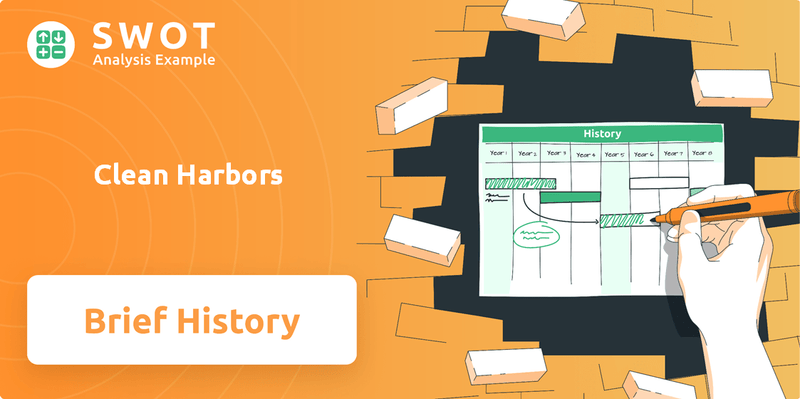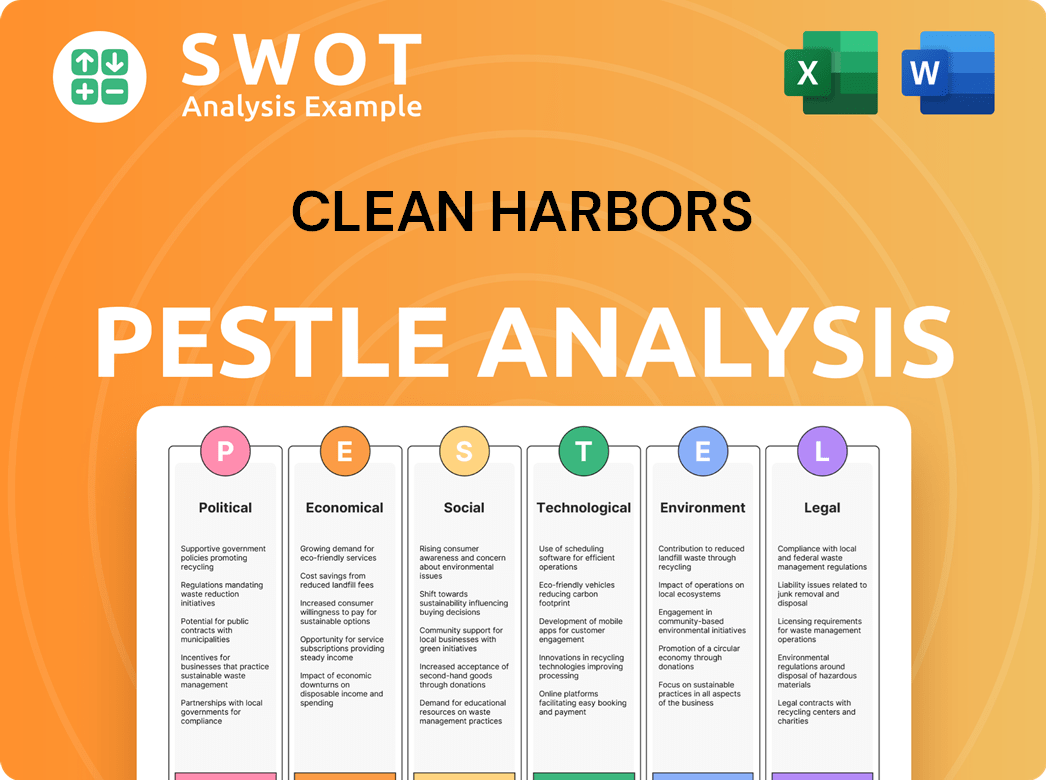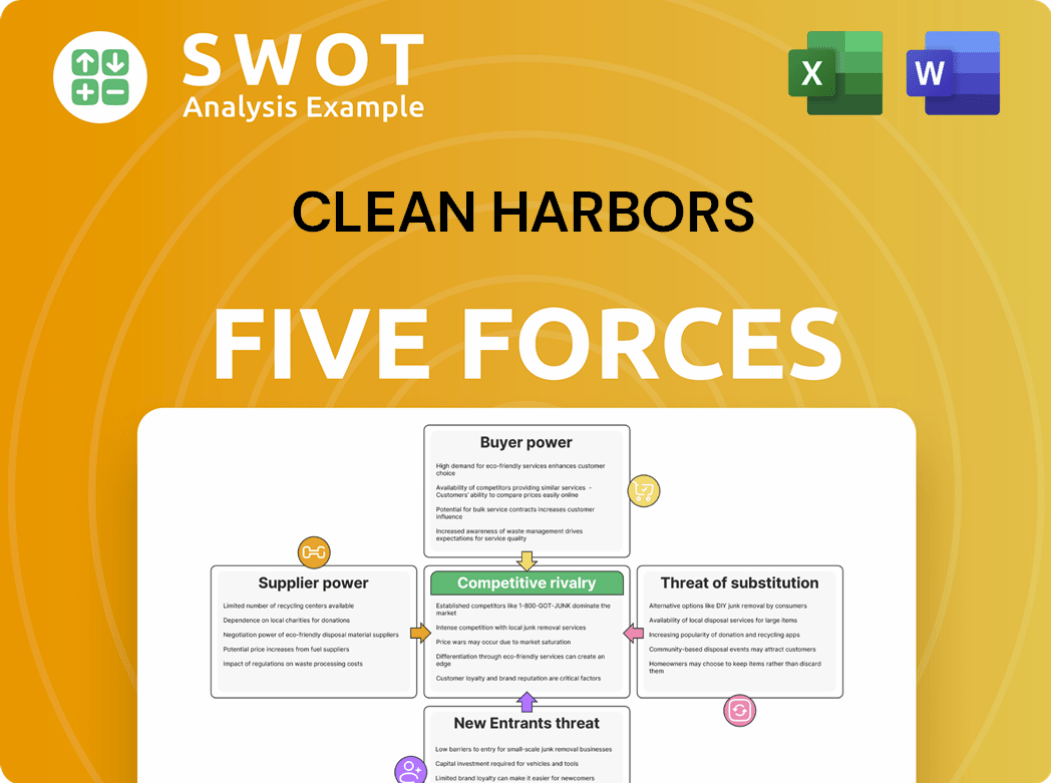Clean Harbors Bundle
How did Clean Harbors become a leader in environmental services?
Clean Harbors, a powerhouse in environmental and industrial services, has a compelling story rooted in its commitment to managing hazardous waste. Founded in 1980, the company's journey from a small startup in Massachusetts to a publicly traded giant is a testament to its strategic vision. With a remarkable revenue of $5.39 billion in 2023, Clean Harbors continues to shape the environmental landscape.

This exploration into the Clean Harbors SWOT Analysis will unveil the key milestones and strategic decisions that propelled Clean Harbors from its early days to its current position as a leader in waste management and environmental services. Understanding the brief history of Clean Harbors, including its founding and evolution, offers crucial insights into its enduring success and impact on the industry. The company's expansion reflects its ability to adapt to evolving environmental regulations and industry demands, solidifying its role as a key player in environmental sustainability.
What is the Clean Harbors Founding Story?
The story of Clean Harbors begins in 1980, with its official founding by Alan S. McKim. McKim, recognizing a growing need for responsible hazardous waste solutions, established the company to address the increasing environmental concerns of the time. This marked the start of what would become a leading provider in environmental services.
Clean Harbors' early focus was on hazardous waste disposal, a niche market expanding due to stricter environmental regulations. McKim's hands-on approach, including his direct involvement in operations, helped build a reputation for reliability. The company's name, 'Clean Harbors,' reflected its commitment to environmental protection, particularly in industrial areas.
Alan S. McKim founded Clean Harbors in 1980, identifying a need for safer hazardous waste disposal. The company started by offering hazardous waste disposal services, directly addressing the growing environmental concerns of the era.
- The company's initial focus was on collecting and disposing of hazardous waste, serving industrial clients.
- McKim used his industry knowledge and personal resources to bootstrap the company.
- The name 'Clean Harbors' was chosen to reflect its commitment to environmental cleanliness.
- The late 1970s and early 1980s saw a rise in environmental consciousness, influencing the company's creation.
The founding of Clean Harbors was significantly influenced by the environmental context of the late 1970s and early 1980s. The Love Canal disaster, among other events, heightened public awareness and created a clear economic opportunity for companies addressing environmental challenges. This period saw the rise of environmental regulations, which Clean Harbors was well-positioned to meet. This created a strong foundation for Clean Harbors' growth, establishing it as a key player in the Competitors Landscape of Clean Harbors.
Clean Harbors SWOT Analysis
- Complete SWOT Breakdown
- Fully Customizable
- Editable in Excel & Word
- Professional Formatting
- Investor-Ready Format

What Drove the Early Growth of Clean Harbors?
The early years of Clean Harbors were marked by strategic expansion and diversification within the environmental services sector. The company quickly grew beyond basic waste disposal, incorporating emergency response services for chemical spills, which capitalized on increasing regulatory demands and industrial incidents. This expansion allowed Clean Harbors to attract major industrial clients seeking comprehensive environmental solutions, solidifying its position in the market.
In the early 1980s,
By the mid-1980s,
A pivotal moment was the company's initial public offering (IPO) in 1987. The IPO provided substantial capital for further expansion and acquisitions. This allowed investment in advanced treatment technologies and expansion into new service lines like industrial cleaning and laboratory chemical disposal.
Revenue steadily climbed, driven by organic growth and strategic entries into new markets, including the Midwest and parts of Canada. Leadership focused on operational efficiency and customer satisfaction. By the early 1990s,
Clean Harbors PESTLE Analysis
- Covers All 6 PESTLE Categories
- No Research Needed – Save Hours of Work
- Built by Experts, Trusted by Consultants
- Instant Download, Ready to Use
- 100% Editable, Fully Customizable

What are the key Milestones in Clean Harbors history?
Throughout its history, Clean Harbors has achieved many significant milestones in the environmental services industry, demonstrating its growth and commitment to waste management solutions. The company's journey is marked by strategic expansions, technological advancements, and a strong focus on environmental responsibility. These achievements have solidified its position as a leader in the field, shaping its impact on the industry and the environment.
| Year | Milestone |
|---|---|
| 1980 | Founded by Alan McKim, Clean Harbors began as a small hazardous waste disposal company. |
| 1980s | Expanded its service offerings through strategic acquisitions, growing its operational footprint and service capabilities. |
| 1990s | Went public, raising capital to fund further expansion and technological advancements in hazardous waste management. |
| 2000s | Expanded its service portfolio to include oil and gas field services, diversifying its revenue streams and market presence. |
| 2010s | Continued strategic acquisitions, including the acquisition of Safety-Kleen, significantly expanding its service offerings and geographic reach. |
| 2020s | Focused on sustainable practices and innovative solutions, including investments in renewable energy and advanced waste treatment technologies. |
Clean Harbors has consistently embraced innovation to improve its service offerings. A key focus has been on developing advanced technologies for treating and disposing of hazardous waste, enhancing both efficiency and safety. The company also secured patents for specialized equipment and processes, which helped them gain a competitive advantage in the market.
Clean Harbors has invested heavily in incineration and wastewater treatment technologies to safely and efficiently handle various waste streams.
The company has developed and patented specialized equipment designed to improve the handling and processing of hazardous materials.
Clean Harbors is actively involved in developing and implementing sustainable waste management solutions, including recycling and waste-to-energy initiatives.
The company has developed specialized equipment and processes, which helped them gain a competitive advantage in the market.
Clean Harbors continues to invest in technological advancements to improve its operational efficiency and environmental performance.
The company has developed and implemented rigorous safety protocols and compliance measures to meet or exceed regulatory standards.
Clean Harbors has faced several challenges, including economic downturns and increased competition. The company has also had to navigate complex regulatory environments, requiring substantial investments in infrastructure and training to meet evolving environmental standards. For more details, you can read a detailed Clean Harbors history.
Economic recessions have impacted industrial activity, affecting the demand for environmental services, requiring strategic adjustments.
Intense competition from established and emerging firms necessitates continuous innovation and strategic adaptation to maintain market share.
Stringent and evolving environmental regulations require significant investments in infrastructure, training, and compliance measures.
Managing complex waste streams and ensuring compliance with EPA regulations present ongoing operational hurdles.
Changes in commodity prices and demand for specific services can create financial and operational challenges.
Responding to major environmental disasters requires significant resources and expertise, impacting the company's operations and reputation.
Clean Harbors Business Model Canvas
- Complete 9-Block Business Model Canvas
- Effortlessly Communicate Your Business Strategy
- Investor-Ready BMC Format
- 100% Editable and Customizable
- Clear and Structured Layout

What is the Timeline of Key Events for Clean Harbors?
The Clean Harbors history is marked by strategic acquisitions and a focus on expanding its environmental services. The company has grown significantly since its founding, becoming a key player in waste management and hazardous waste solutions.
| Year | Key Event |
|---|---|
| 1980 | Founded by Alan McKim, Clean Harbors began as a small hazardous waste disposal company. |
| 1980s | Clean Harbors expanded its services and geographic reach through acquisitions, establishing a broader presence in the environmental services sector. |
| 1990 | The company went public, further fueling its growth through capital investments and strategic acquisitions. |
| 2000s | Clean Harbors continued to grow, acquiring competitors and expanding its service offerings to include emergency response, industrial services, and more. |
| 2023 | Clean Harbors reported revenues of approximately $5.59 billion, reflecting its continued growth and market leadership. |
Clean Harbors is likely to further diversify its service offerings. This could include expanding into emerging areas of waste management and environmental remediation. The company may also invest in new technologies to improve efficiency and reduce environmental impact.
Acquisitions will likely remain a key part of Clean Harbors' growth strategy. The company may target businesses that complement its existing services or expand its geographic footprint. This approach has been successful in the past and is likely to continue.
With increasing environmental awareness, Clean Harbors will likely prioritize sustainable practices. This includes investing in technologies for waste reduction, recycling, and renewable energy. The company may also focus on helping its clients meet their sustainability goals.
The company is expected to leverage technological advancements to improve its operational efficiency. This could include using data analytics for better waste management and implementing automation in its facilities. These advancements are critical for staying competitive.
Clean Harbors Porter's Five Forces Analysis
- Covers All 5 Competitive Forces in Detail
- Structured for Consultants, Students, and Founders
- 100% Editable in Microsoft Word & Excel
- Instant Digital Download – Use Immediately
- Compatible with Mac & PC – Fully Unlocked

Related Blogs
- What is Competitive Landscape of Clean Harbors Company?
- What is Growth Strategy and Future Prospects of Clean Harbors Company?
- How Does Clean Harbors Company Work?
- What is Sales and Marketing Strategy of Clean Harbors Company?
- What is Brief History of Clean Harbors Company?
- Who Owns Clean Harbors Company?
- What is Customer Demographics and Target Market of Clean Harbors Company?
Disclaimer
All information, articles, and product details provided on this website are for general informational and educational purposes only. We do not claim any ownership over, nor do we intend to infringe upon, any trademarks, copyrights, logos, brand names, or other intellectual property mentioned or depicted on this site. Such intellectual property remains the property of its respective owners, and any references here are made solely for identification or informational purposes, without implying any affiliation, endorsement, or partnership.
We make no representations or warranties, express or implied, regarding the accuracy, completeness, or suitability of any content or products presented. Nothing on this website should be construed as legal, tax, investment, financial, medical, or other professional advice. In addition, no part of this site—including articles or product references—constitutes a solicitation, recommendation, endorsement, advertisement, or offer to buy or sell any securities, franchises, or other financial instruments, particularly in jurisdictions where such activity would be unlawful.
All content is of a general nature and may not address the specific circumstances of any individual or entity. It is not a substitute for professional advice or services. Any actions you take based on the information provided here are strictly at your own risk. You accept full responsibility for any decisions or outcomes arising from your use of this website and agree to release us from any liability in connection with your use of, or reliance upon, the content or products found herein.